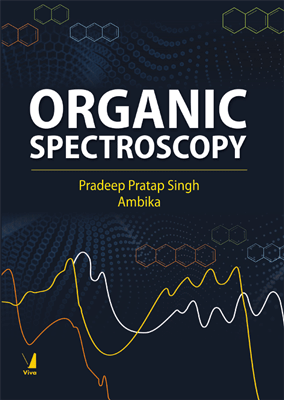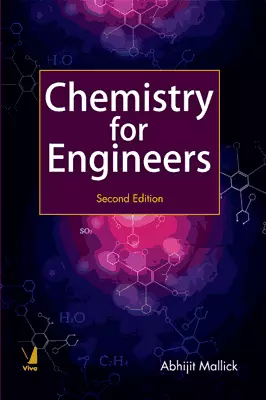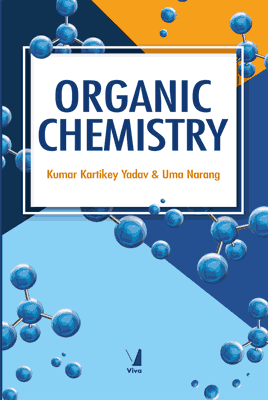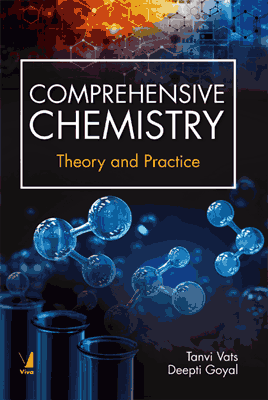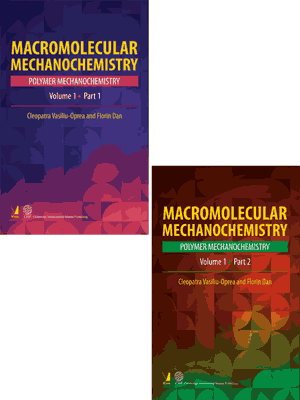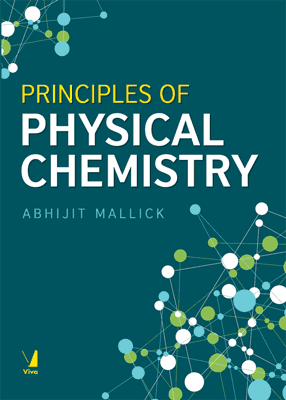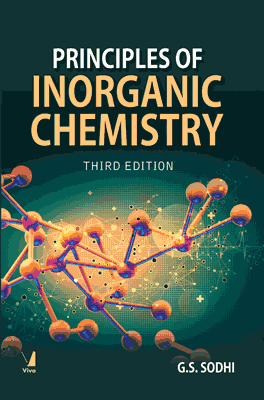Organic Spectroscopy
Organic Spectroscopy
₹292.50 ₹325.00 Save: ₹32.50 (10%)
Go to cartISBN: 9789387925120
Bind: Paperback
Year: 2018
Pages: 232
Size: 172 x 242 mm
Publisher: Viva Books Originals
Sales Territory: Worldwide
Description:
The book Organic Spectroscopy deals with UV-Visible, IR, 1H NMR, 13C NMR, and mass spectrometry along with spectroscopic solution of the structural problems. The book covers the basic theory, instrumentation and the structure-spectra correlations of the major spectroscopic techniques. In addition, the book acquaints students with the methods to determine the structure of an unknown compound in a (reasonably) logical manner with the help of all major spectroscopic techniques. The authors aim to provide spectra to illustrate every point made, but do analyze fully each of the spectra in order to obtain the maximum information available. Learning by solving problems gives more competence and confidence in the subject. So, the book includes, wherever required, numerous solved and unsolved problems that will help students to understand the concepts easily and obtain structures from spectra. The book is; therefore, a collection of such problems to help students acquaint with the basics of spectroscopy.
Target Audience:
For students of B.Sc.(Hons.) and B.Sc.(Prog.) Chemistry, M.Sc.(Chemistry).
Contents:
Preface
Chapter 1. Introduction to Spectroscopy • Spectroscopy and Spectrometry • Origin of Molecular Spectra • Electromagnetic Spectrum • Radiowave • Microwave • Infrared • UV-Visible • X-rays • Types of Spectra • Continuous Spectra • Discrete Spectra • Emission line spectra • Absorption line spectra • Double Bond Equivalents (Hydrogen Deficiency Index) • Determination of Structure from Spectra
Chapter 2. UV-Visible Spectroscopy • Introduction • Different Regions of UV-Visible Spectroscopy • Different Electronic Transitions • s-s* Transitions • n-s* Transitions • p-p* Transitions • n-p* Transitions • Selection Rule • Origin of UV-Visible Spectrum • Designation of UV-Bands • R-Bands (German, Radical like) • K-Bands (German or Conjugated) • B (Benzenoid) and E (Ethylenic) Bands • Beer-Lambert Law • Instrumentation for UV-Visible Spectroscopy • Single Beam Spectrometers • Double Beam Spectrometers • Photodiode Array Spectrometer (Multi-channel Instrument) • Some useful terms in Ultraviolet-Visible Spectroscopy • Solvents used in the UV-Visible Spectrophotometry • Chromophores • Effect of Substitution on the Chromophore • Bathochromic shift (Red shift) • Hypsochromic shift (Blue shift) • Hyperchromic shift • Hypochromic shift • Effect of Conjugation on the Chromophore • Effect of Solvent on the Chromophore • Effect of pH on the Chromophore • Effect of Steric Hindrance on the Chromophore • Auxochromes • Isosbestic Point • Woodward-Fieser Rules • Woodward-Fieser Rules for Calculating the ?max Values in Dienes • Acyclic dienes • Cyclic dienes • Woodward-Fieser Rules for Calculating the ?max Values in Unsaturated Carbonyl Compounds (Enones) • Woodward-Fieser Rule for Calculating the ?max Values in Aromatic Carbonyl Compounds • Applications of UV-Visible Spectroscopy • Detection of Functional Groups • Extent of Conjugation • Distinction between Conjugated and Non-conjugated Compounds • Identification of an Unknown Compound • Quantitative Analysis • Examination of Polynuclear Hydrocarbons • Determination of the Strength of Hydrogen Bonding • Study of Charge Transfer Complexes • Study of Chemical Reactions • Keto-Enol Tautomerism
Chapter 3. Infrared Spectroscopy • Introduction • Hooke's Law • Instrumentation • Fourier Transform Infrared Spectroscopy (FTIR) • Selection Rules • Some useful Terms in Infrared Spectroscopy • Infrared Region of the Electromagnetic Spectrum • IR Spectrum • Relationship between Wavenumber and Wavelength • Relationship between Absorbance and Transmittance • Functional Group and Fingerprint Region • Absorption of Infrared Radiation • Molecular Vibrations • Stretching vibrations • Bending vibrations (Deformations) • Factors Affecting the Absorption Frequencies • Hybridisation • Electronic Effects • Inductive effect • Resonance effect • Hydrogen Bonding • Ring Strain and Size • Vibrational Coupling • Isotope Effect • Characteristic Group Vibrations • Functional Group Region (4000?1500 cm?1) • 4000?2300 cm?1 • N?H stretching (3500?3300 cm?1) • 2300?1850 cm?1 • 1850?1500 cm?1 • Fingerprint Region (1500?600 cm?1) • 1500?1000 cm?1 • 1000?666 cm?1 (Bending vibrations) • Applications of IR Spectroscopy • Detection of Functional Groups • Effect of Different Types of Hydrogen Bonding • Effect of Position of Substituent on Stretching Frequency • Study of Chemical Reactions • Keto-Enol Tautomerism in Organic Compounds • Geometrical Isomerism • Interpretation of the Infrared Spectra
Chapter 4. Proton Nuclear Magnetic Resonance (NMR) Spectroscopy • Introduction • Nuclear Spin States and Magnetic Moment • The Energy Absorption and Relaxation Phenomena • The Resonance Phenomenon • Relaxation Processes • Spin-lattice relaxation (T1) • Spin-spin relaxation (T2) • The NMR Spectrum • Instrumentation in NMR Spectroscopy • Continuous Wave Spectroscopy • Fourier Transform Spectroscopy • Parameters of NMR Spectroscopy • Shielding and Deshielding of the Nucleus • Chemical Shift • Chemical Equivalence • Magnetic Equivalence • Homotopic groups • Enantiotopic groups • Diastereotopic groups • Nature of the Solvent • NMR Water Signals • Factors Affecting Chemical Shift • Inductive Effect • Anisotropic Effect • Hybridisation • Protons attached with sp3 hybridised carbon • Protons attached with sp2 hybridised carbon • Protons attached with sp hybridised carbon • Hydrogen Bonding • Temperature • Origin of Signal Splitting • Signal Coupling • Geminal coupling • Vicinal coupling • Trans coupling • Aromatic coupling • Long range coupling • Coupling Constant (J) • Multiplicity (Spin-spin Splitting/Spin-spin Coupling or n+1 Rule) • Relative Intensity of Lines in a Multiplet • Analysis of the NMR Spectrum • First Order Spectra • Non First Order Spectra • Simplification of Complex NMR Spectrum • Increased Field Strength • Spin Decoupling or Double Resonance (Double Irradiation) • Deuteration-deuterium Exchange and Deuterium Labelling • Shifts Reagent • Applications of 1H NMR Spectroscopy • Detection of Aromaticity • Detection of Rate Constant by Environmental Exchange and Line Broadening • Distinction between cis-trans Isomers and Conformers • Detection of Partial Double Bond Character • Quantitative Analysis in Keto-Enol Tautomerism • Interpretation of Spectra
Chapter 5. 13C NMR Spectroscopy • Introduction • Natural Abundance of Carbon-13 • Some Useful Terms • Referencing 13C NMR Spectra • Chemical Shift Equivalence • Chemical Shifts • Factors Affecting 13C Chemical Shifts • Inductive Effect • Effect of Hybridisation • Effect of Substituent on Alkanes • a-Substituent effect • ??-Substituent effect • ?-Substituent effect • Effect of Substituent on the Chemical Shift of Carbonyl Carbons • Effect of conjugation • Effect of hydrogen bonding • Calculation of Chemical Shift in Alkanes • Mode of Recording 13C NMR Spectra • Proton Noise Decoupling • Off Resonance Decoupling • Distortionless Enhancement by Polarisation Transfer (DEPT) 13C Spectra • Gated Decoupling • Spin-spin Coupling • Applications of 13C NMR Spectroscopy • Detection of a Double Bond and Distinction between cis and trans Alkenes • Determination of Acyclic syn-anti Stereochemistry
Chapter 6. Mass Spectrometry • Introduction • Instrumentation • Ionisation Chamber (Ion Source) • Mass Analyser • Detector • Ionisation Techniques • Electron Impact (EI) • Chemical Ionisation (CI) • Atmospheric Pressure Chemical Ionisation (APCI) • Fast Atom Bombardment (FAB) • Electrospray Ionisation (ESI) • Matrix Assisted Laser Desorption Ionisation (MALDI) • Some useful Terms used in Mass Spectrometry • Molecular Ion • Fragmentation • Cleavage • Rearrangement • Loss of Small Molecules • Isotope Abundance • Metastable Ions • Even-electron Rule • Nitrogen Rule • McLafferty Rearrangement • Application of Mass Spectrometry • Fragmentation Modes of Various Classes of Organic Compounds • Hydrocarbons • Alkyl halides • Hydroxyl compounds • Aldehydes • Ketones • Carboxylic acids, esters and amides • Fragmentation of ethers • Esters • Amines • Amides • Nitro compounds • Nitriles • Heterocyclic compounds • How to Analyse Mass Spectra
Practice Problems
Appendix
Index
About the Authors:
Dr. Pradeep Pratap Singh is currently working as an Assistant Professor in the Department of Chemistry, Swami Shraddhanand College, University of Delhi. He did his M.Phil. and Ph.D from the Department of Chemistry, University of Delhi. He has published 9 papers in lnternational journals and 14 chapters in lnternational books.
Dr. Ambika is currently working as an Assistant Professor in the Department of Chemistry, Hansraj College, University of Delhi. She did her M.Sc. and Ph.D from the Department of Chemistry, University of Delhi. She has published 9 papers in lnternational journals, 15 chapters in lnternational books and 2 research projects to her credit.
Dr. Pradeep Pratap Singh is currently working as an Assistant Professor in the Department of Chemistry, Swami Shraddhanand College, University of Delhi. He did his M.Phil. and Ph.D from the Department of Chemistry, University of Delhi. He has published 9 papers in lnternational journals and 14 chapters in lnternational books.
Dr. Ambika is currently working as an Assistant Professor in the Department of Chemistry, Hansraj College, University of Delhi. She did her M.Sc. and Ph.D from the Department of Chemistry, University of Delhi. She has published 9 papers in lnternational journals, 15 chapters in lnternational books and 2 research projects to her credit.
